Reservoir Safety Reform Programme Information Page
Overview
We are developing and delivering the Reservoir Safety Reform Programme, in response to the recommendations set out in the Independent Reservoir Safety Review Report.
In a Written Ministerial Statement in July 2022 the Government set out its intention to reform reservoir safety management practices and modernise the Reservoirs Act 1975.
The Reservoir Safety Reform Programme will be delivered in a phased way over several years, by the Department for Environment, Food and Rural Affairs (Defra) and the Environment Agency (EA). We will use this information page to keep you updated on our plans and progress.
Introduction
Reservoir safety is about ensuring the physical structure of a reservoir, its dams and embankments are safe. In England, around 2.2 million people are potentially at risk from reservoir dams failing and causing flooding which could endanger life.
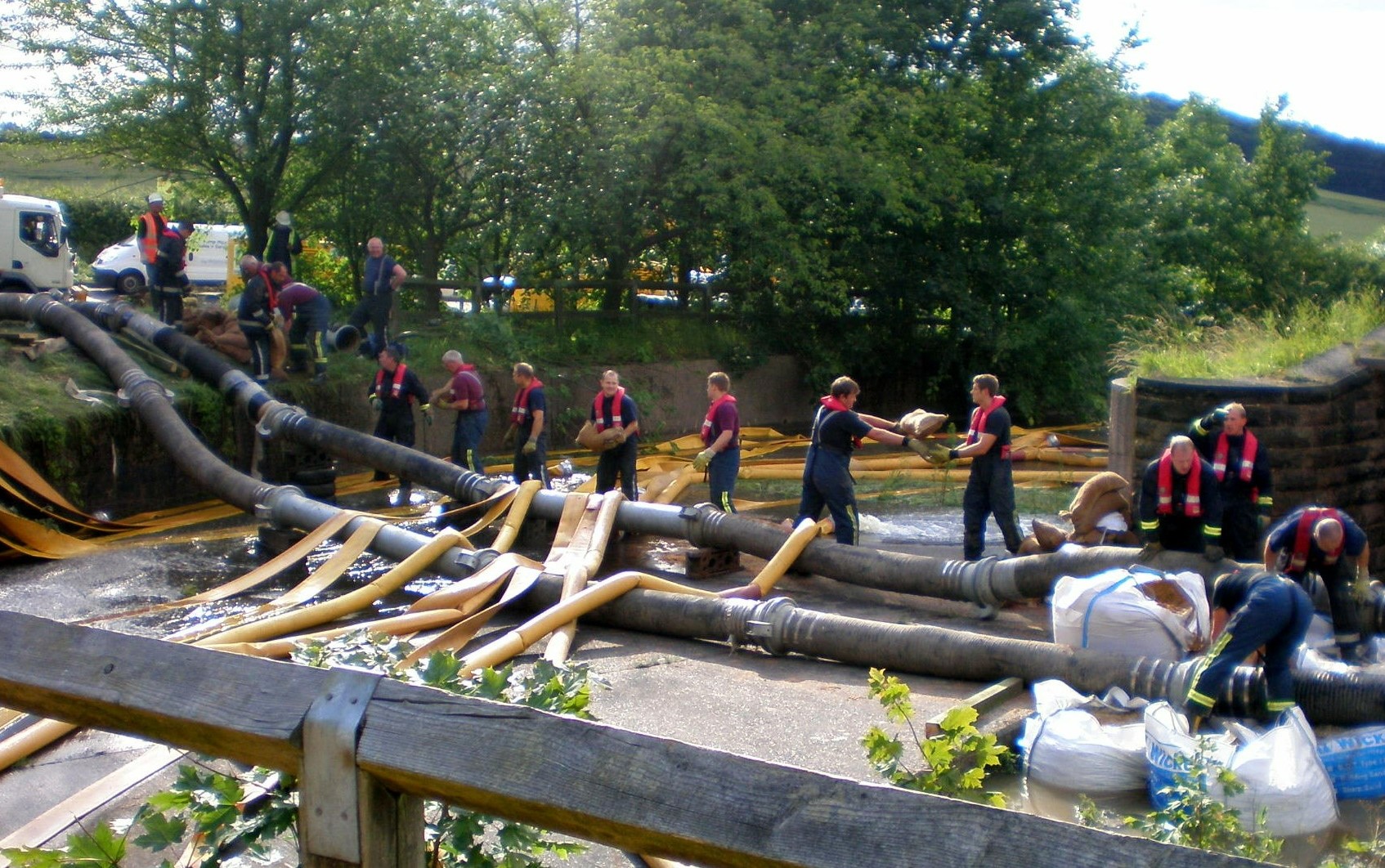
We have an excellent reservoir safety record. However, the Toddbrook incident in 2019, increasing demands on water supply, and the impacts of climate change, are all reasons to re-evaluate how we regulate reservoir safety.
Programme vision & aims
Our vision is to create a safety regime for reservoir dams in England which protects our communities, by making us ready for and resilient to climate change – today, tomorrow and the future. We will do this by:
-
Strengthening the roles and responsibilities for reservoir owners, operators, engineers, and the regulator (EA).
-
Improving the safety practice and culture, through a programme of continuous development of skills, capacity and training across the reservoir community.
-
Modernising legislation and safety management practice to ensure a robust and proportionate safety regime that is fit for the future.
-
Engaging with stakeholders to help shape our approach and deliver reforms.
The need for reform
The key drivers for improving the reservoir safety system are:
-
The Toddbrook incident and the Independent reservoir safety review.
-
Climate change - which is increasing the pressures on reservoir infrastructure and demand for reservoirs and water resources.
-
The need to update the 1975 Reservoirs Act to bring it in line with modern safety management practice in other sectors.
-
The declining numbers of reservoir engineers and the increasing demand for specialist engineers in future.
Changes already implemented
-
We have worked with reservoir owners on emergency flood plans for all large, raised reservoirs. It is now a legal requirement for reservoir owners to produce and maintain on-site emergency flood plans. As of December 2022 all large, raised reservoirs are compliant. The requirement is notified to new owners when their reservoirs are registered.
-
We have now revised, updated and published reservoir flood maps for over 2,000 large raised reservoirs. We share this information with our emergency responders to ensure accurate information is available for emergency planning. The maps can be found at https://environment.data.gov.uk/reservoir-flood-maps/.
-
We have created a dedicated page on gov.uk for reservoir safety guidance documents. We hope this will make finding the guidance you need easier. We have already developed and published new guidance to support engineers and owners. This will ensure all inspections by supervising and inspecting engineers are systematic, detailed, and impartial. We also published new research into spillway design, examination and failure mechanisms.
-
We commissioned the Institution of Civil Engineers to review how we safeguard the future supply of reservoir engineers. The report was published in February 2023. The recommendations made in the report will be taken forward alongside the reform programme.
- We are driving forward progress against the other recommendations from the independent reservoir safety review and plan to consult further in the coming year.
Devolved administrations
Reservoir safety policy is devolved. The reform programme is focused on England. The devolved administrations will decide whether and how to implement changes in their countries. We are working closely with the devolved administrations to share knowledge and help ensure a coherent approach to reservoir regulation across the UK.

Key reforms
Overall roles and responsibilities
Responsibilities for reservoir safety regulation are divided between the following three communities, which together ensure almost 2.2 million people in England, who live near reservoirs, are not put at any unnecessary risk of flooding, which could endanger life:
-
Reservoir owners and operators, who are responsible for the safety of their reservoirs. They must appoint engineers from the reservoir panels of engineers to inspect their reservoirs and they must act on the engineer’s recommendations.
-
Reservoir panel engineers, who are appointed to supervise and inspect reservoir construction and operation.
-
The Environment Agency manages and enforces reservoir safety regulation in England.
The reform programme aims to strengthen and modernise safety procedures. It will not change this overall three way approach, but will mean some changes for all of these communities.
Programme of reforms
Our programme of reforms to strengthen and modernise the regime will be implemented through a combination of guidance, secondary legislation and new primary legislation, when parliamentary time allows.
Scope of regulation
We are currently reviewing the definition of large, raised reservoirs to ensure that the regulatory requirements apply to the right set of structures and features.
New hazard classification
We have commissioned work to develop a new hazard classification which better reflects the level of risk from reservoir failure, and the arrangements for how it would operate. This includes looking at good safety management practice in other countries and sectors and how this might be used to improve our reservoir safety management practice. The project is involving stakeholders in shaping the details of the classification and what that could mean in practice for reservoir owners and engineers.
The research and development project has been extended to include Wales and will provide data and analysis in relation to Welsh Reservoirs. Defra, the Environment Agency, Welsh Government and Natural Resources Wales are working closely to develop options for the new classification and safety management system that are suitable for both countries.
In the current system reservoirs are classified as either high risk or not high risk. The aim is to have an approach with more hazard classes and so greater scope for differentiation in how reservoirs are regulated. Reservoirs which are in the higher hazard classes may be subject to more regulatory requirements and those which are in lower hazard classes would have fewer requirements.
We are currently surveying reservoir owners and engineers to identify the locations of small, raised reservoirs across England (i.e. reservoirs which are capable of holding 10,000 -25,000 m3 water above ground level). We have created a briefing note, which explains our work in more detail and may be able to answer some of your enquiries. Gathering information about existing structures is a key step in determining whether such reservoirs should be regulated. The information will help us assist with developing proposals for the new hazard classification. If you believe you have a small raised reservoir on your land, please complete the form or email the details to reservoirs@environment-agency.gov.uk.
Records, registers and management systems
We are currently reviewing recommended changes to the management arrangements for reservoir safety. This includes improvements to systems that ensure operation, maintenance, monitoring and surveillance are being effectively delivered. The review is also looking to update the existing record and information keeping requirements to streamline data management practices and improve efficiency, and effectiveness.
Reservoir safety management system reforms are closely linked to the hazard classification proposals. The complexity of the system and level of reservoir engineer involvement is likely to be in proportion to the risk posed by the reservoir. System development will also take account of ongoing stakeholder consultation and research into the application of reservoir on-site emergency plans. A presentation of the analysis from this research will be held for stakeholders in summer 2024.
We have recently commissioned a baseline study into current industry best practice and to look at options available for improving management systems. This study includes a review of possible information requirements and associated roles and responsibilities. It is due to conclude in early summer 2024 and will provide the evidence base for detailed proposal development, future consultation and associated legislation.
Reservoir engineer reforms
We are working closely with the Institution of Civil Engineers (ICE), and their new Panel Engineers Committee, on actions to increase the capacity and capability of supervising and inspecting engineers across England. These actions stem from recommendations in the Independent reservoir safety review and the Future Supply of Engineers Report.
Benefits to the engineering community
The changes will offer a range of benefits to the engineering community, for example:
- Bringing more engineers into the industry, through a recruitment programme to encourage graduates into reservoir engineering careers. This will reduce the burden of work currently experienced by both supervising and inspecting engineers, and ensure we have enough resource for future demand.
-
Supporting the career progression of panel engineers. We will align their career path to the new hazard risk classifications and provide them with the additional learning and development opportunities they need to succeed.
We are developing a mentoring programme to support panel engineers who wish to progress to the All Reservoirs Panel. We have surveyed our engineer community to develop data on the potential pipeline of All Reservoir Panel Engineers and to identify potential candidates to support. -
Securing the quality and standards of all inspection reporting and monitoring, carried out by panel engineers, through the creation of a capability process. Working with Defra and the Welsh Government ICE have published the Reservoir Pannel Engineer Capability Process. This process monitors the capabilities of engineers, identify gaps in knowledge and provides training where needed, to continually improve the technical knowledge and expertise provided by engineering panels.
We have also been working with our new Panel Engineer Committee and have surveyed our engineers to help us to identify inefficient processes and unnecessary tasks. This will enable us to identify tasks that could be reformed or eliminated, consistent with moving to a more proportionate, risk-based approach to reservoir safety.
Reservoir owner reforms
We have published guidance on Reservoirs: owner and operator requirements, to explain what you have to do if you own or operate a reservoir, or intend to build one. In addition, we have also produced a ‘Quick guide to the Reservoirs Act for Owners and Operators’ as an introduction of "how" to operate a reservoir. This guide highlights key activities you should be doing at your reservoirs, information about different types of reservoirs and what to look out for on your dam. This is a new document, and we would welcome any feedback from you. Please contact us at reservoirs@environment-agency.gov.uk.
New reporting system for recording incidents
The Independent Reservoir Safety Review highlighted the importance of thorough incident reporting. We have updated our incident reporting forms, and they are available at Report a reservoir incident. We will use this to support research into how we can better protect people. We will provide the links to the updated forms by early May.
We have worked with the ICE Panel Engineers Committee to streamline our information collection and make our forms easier for owners and engineers to complete. We have created the option of using a near-miss form to report near misses. Though this is voluntary, we hope that capturing lessons learned will drive safety improvements. The requirement for statutory incident reporting remains.
We have reviewed how we categorise incidents. Incidents that fall into category 1 or 2 (Failure or Incident), need to be recorded in the Report a reservoir incident – Part A: Preliminary report and report a reservoir incident - Part B: Final report. These can be submitted together if appropriate for your incident. A near miss needs to be recorded in the Report a Near Miss form. You only need to send one form for a near miss.
We will be looking at how to share lessons from incidents faster and more effectively. If you have ideas on what you would like to see from incident reporting outputs, please contact reservoirs@environment-agency.gov.uk.
Environment Agency reforms to duties & powers
New duties to inspect reports and annual statements.
The Reservoir Safety Review recommended that the Environment Agency should have the powers to question and challenge supervising engineers’ annual statements, inspecting engineers’ reports, risk assessments and reservoir management plans. These new duties will improve the quality and consistency of engineer reports and provide an ongoing national assessment, to help develop guidance and training.
As part of the Reservoir Act Compliance Enforcement project, we are currently reviewing how annual statements (Section 12s) are created and submitted. We are currently trialling a new process to gather feedback from engineers and undertakers. The proposed service would allow supervising engineers to access an online system and download an annual statement template which will be prepopulated. This change is part of the Environment Agency’s shift to digital-by-default. We hope the new system will improve consistency in statements and make the administration process for statements more streamlined.
Creating an ongoing national assessment
As part of our standards framework, we have developed a process to review reports and statements to create an ongoing national assessment.
These templates have been shared with the industry along with the new Supervising Engineer Guidance on writing statements, this along with the new RACE portal will dramatically improve the quality of S12 statements in the future.
We presented a baseline of 41 Supervising Engineer Statement reviews at the Supervising Engineer Forum in 2023. These figures below form the baseline going forward into 2024.
We have now carried out 110 S12 reviews. There has been a marked improvement in the standard of statements. The top 3 problem areas for statutory requirements, non-statutory and guidance areas are illustrated below:
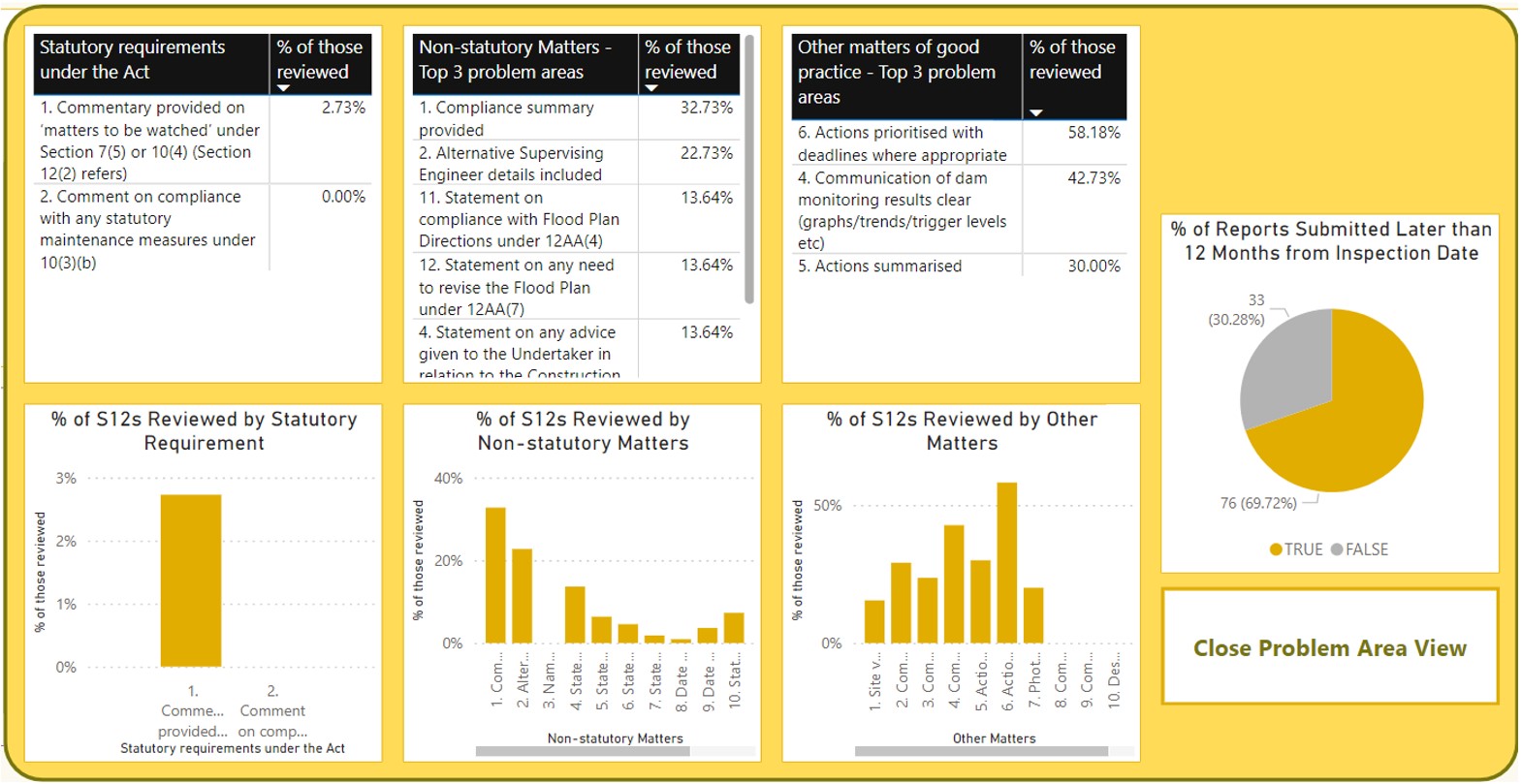
We presented a baseline of 33 S10 reviews to the Inspecting Engineers Forum in 2023. These figures below form the baseline going forward into 2024.
We have now carried out 41 S10 reviews. There has been an improvement in the standard of reports. The top 3 problem areas for statutory requirements and guidance areas are illustrated below:
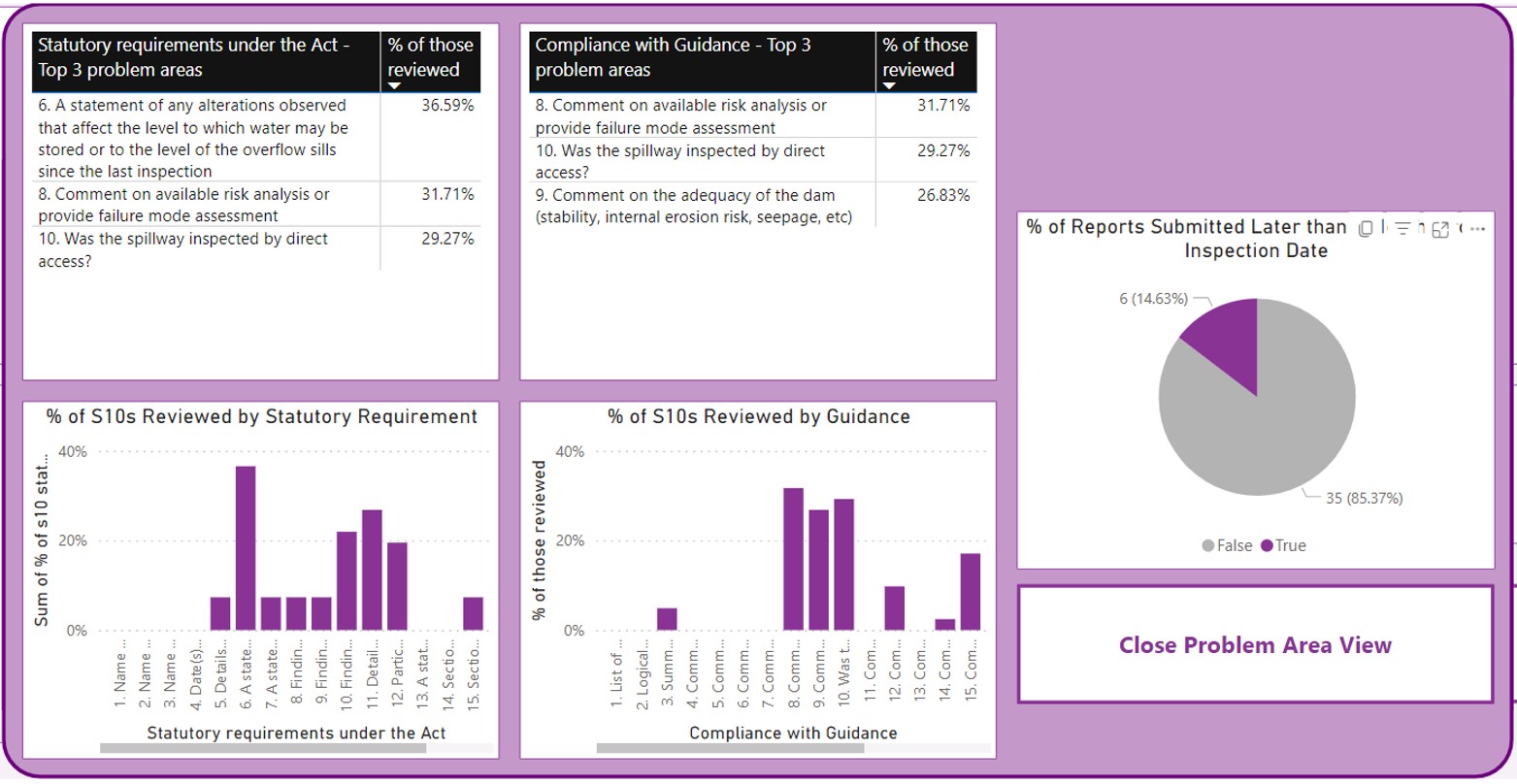
We are using this information to develop the Standards Framework, by apply consistent assessments of S12 and S10 reports to create an on-going national assessment. We are developing a training strategy, updating guidance, and using this information to inform legislative changes.
We have produced new S10 Guidance presented it to Panel Engineer Committee (PEC) and surveyed all panel engineers. There is support and agreement with the new process. The guidance will help improve the clarity and consistency of reports and make them easier for reservoir owners to understand what is required.
Post implementation reviews of regulations
We have reviewed two sets of existing reservoir safety regulations under the Reservoirs Act. There is a requirement to review them every 5 years to check how these are operating and whether they remain fit for purpose. The Post Implementation Reviews can be found here:
The reviews recommend retaining the regulations and have identified some areas where the regulations can be improved. These are being included within the reservoir reform programme and proposals for changes to the regulations will be consulted on.
Engagement and programme timeline
Engagement
Survey to gather information on small, raised reservoirs
If you believe you have a small raised reservoir, please complete this survey to help us identify small, raised reservoirs across England.
New processes for creating an ongoing national assessment
We are trialling a new process to gather feedback from engineers and undertakers on how annual statements (Section 12s) are created and submitted. If you are interested in being involved, or have any questions on this project please contact reservoirs@environment-agency.gov.uk quoting “RACE2 Digital Project”.
On-going engagement
We are engaging regularly with the industry and professional bodies such as Institution of Civil Engineers (ICE), National Farmers Union (NFU), Association of Drainage Authorities (ADA) etc. We encourage you to share your views with your representative body so that they can represent your interests in shaping the reforms.
Timeline for changes
The programme will be delivered over several years through new secondary legislation, guidance, and primary legislation (when parliamentary time allows). Timings are provisional and may change as the programme progresses. The details of what will be included in each legislative stage may change.
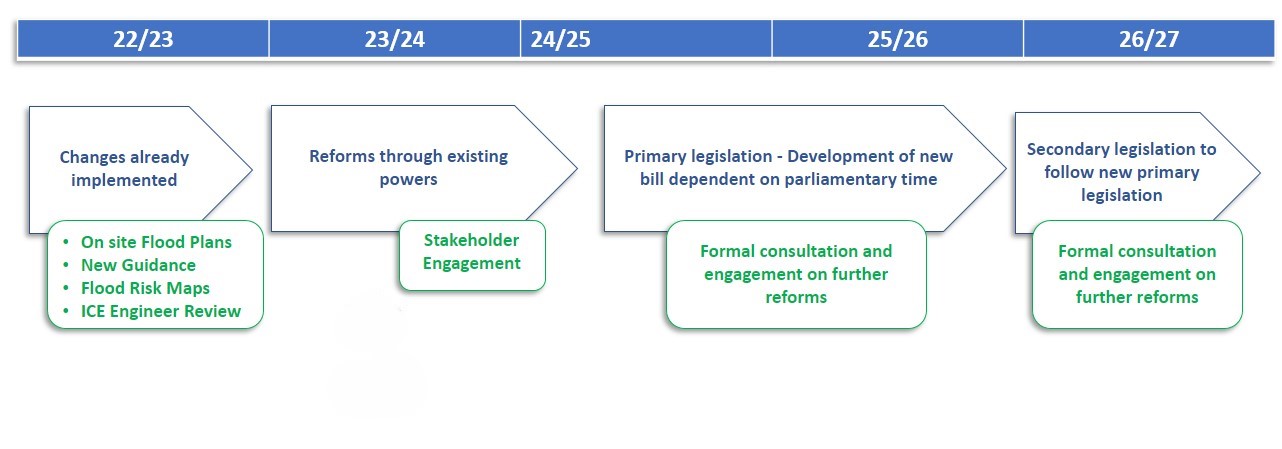
Disclaimer: Images used in this page, including the banner are sourced via Getty Images.
Get in touch:
By email: RSR_Programme@environment-agency.gov.uk
By phone: 03708 506506 (8am to 6pm, Monday to Friday). This is the National Customer Contact Centre. Please ask to speak to a member of the Reservoir Safety Reform Programme Team.
For more information on how we will use and share your data, please see our Privacy Notice and our Personal Information Charter.
Audiences
- Businesses
- Charities
- Statutory organisations
- NGOs
- Members of the public
- Elected representatives, including MPs
- Local councils
- Academics
- The nuclear industry
- All water abstractors
- Environment Agency customers
- Angling trade contacts
- IDBs
- Local authorities
- District and parish councils
- Environmental bodies
- Land owners
- Farming associations
- Drainage associations
- RFCCs
- Elected representatives, including MPs
- Water companies
- Members of the public
- Recreational and commercial river users
- Community groups
- Flood action groups
- Operators
- Other regulators
- Community groups
- Non-governmental organisations with an interest in environmental issues
- Environment Agency colleagues
- Lead Local Flood Authorities
- Local Risk Management Authorities
- Flood Resilience Forums
- Somerset Rivers Authority
- Members of the public
- Town and parish councils
- Regional Flood and Coastal Committees
- Internal Drainage Boards
Interests
- Business and industry
- Flood management
- Fishing and boating
- Water resources
- Water quality
- Drought
- Specific projects, issues, or activity pages

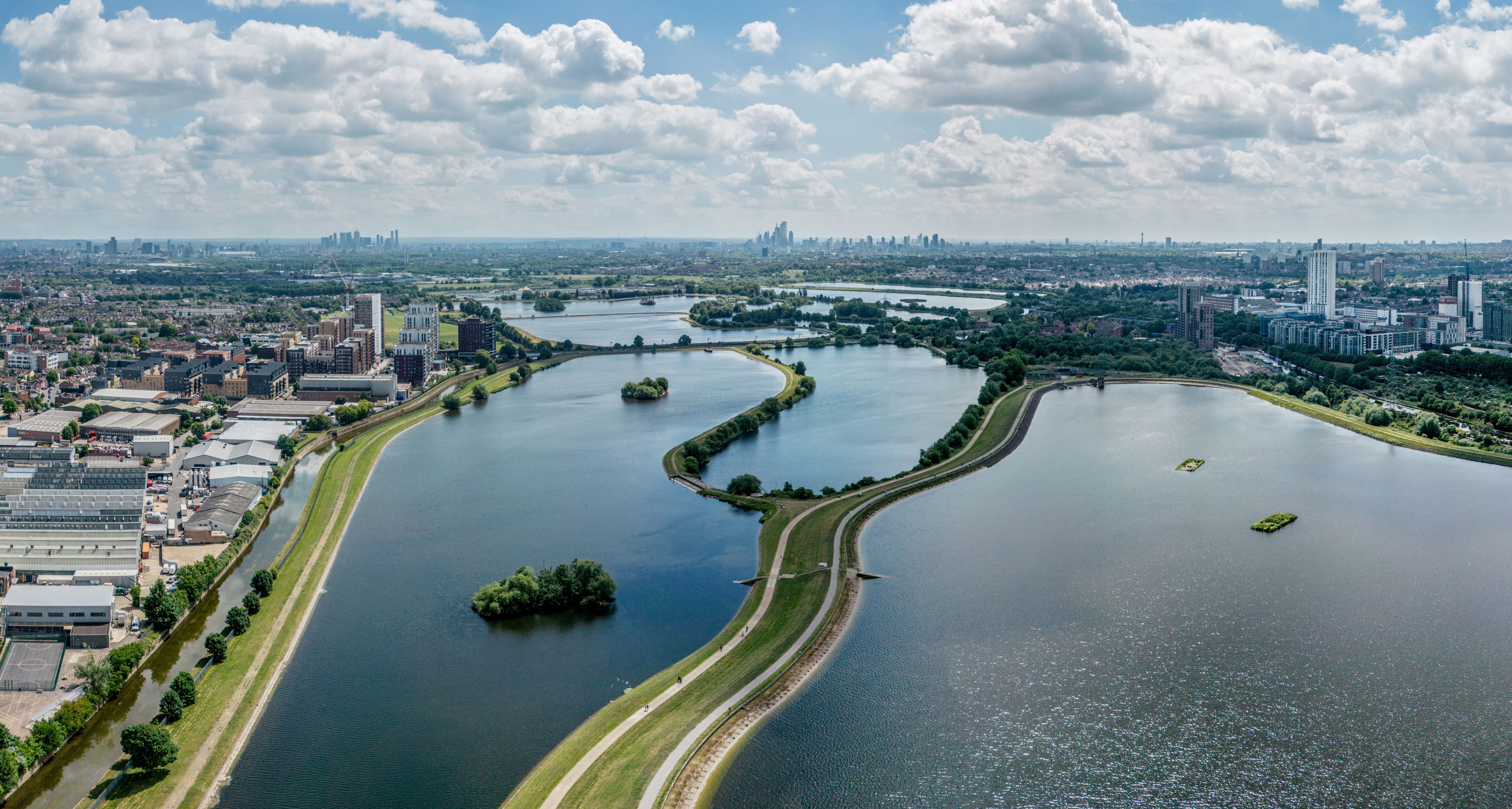
Share
Share on Twitter Share on Facebook